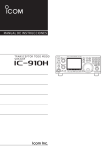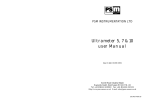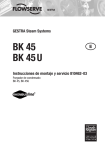Download series 290/3000 differential pressure transmitters user manual
Transcript
PSM INSTRUMENTATION LTD SERIES 290/3000 DIFFERENTIAL PRESSURE TRANSMITTERS USER MANUAL Models covered: 3660/DP, 3670/DP, 3675/DP, 290/DP, 292/DP & 295/DP Issue 2 date 10th June ‘97 Burrell Road Industrial Estate Haywards Heath, West Sussex RH16 1TW, UK Tel: +44 (0)1444 410040 Fax: +44 (0)1444 410121 Http://www.psm-sensor.co.uk E-mail: [email protected] 1 INDEX SECTION TITLE PAGE 1 Introduction 4 2 Specifications 5 6 Model coding 3 Transmitter Installation Mechanical General arrangement Drawings 8 9 4 Transmitter Installation Electrical 10 5 Commissioning 11 11 Range & Zero adjustment 6 Fault Finding 12 3 1. INTRODUCTION Series 3000 and 290 differential pressure transmitters are intended for applications across a wide range of processes from ultra low to medium pressure duties. Different constructions and materials are available to suit a particular duty The measurement principle is based on a precision rated diaphragm and linear variable differential transformer (LVDT) combination. On all models the pressure chamber houses a rated pressure element to which the process pressure is directly applied. Backing plates are provided to protect against pressure overloads, and full asymmetric protection is achieved on certain models by employing a hydraulically linked dual diaphragm assembly, The pressure element is attached to a ferro magnetic core which is located in the centre (null point) of a high resolution linear variable differential transformer(LVDT). When voltage is applied to the primary coil, any movement of the core due to pressure on the measuring element develops a voltage in the two secondary coils. The output signal from these two coils is then conditioned within the transmitter electronics to provide a standard process control signal output, which, using the adjustments provided, may be set by the user to the process requirements. 4 2. SPECIFICATIONS - General Mechanical Electronics Housing Integral models: Remote models: Pressure housing: Diaphragm material: Remote sensor cable: Process connections: Electrical connections: Integral models: Remote models: Electrical Maximum error: Stainless steel to IP65 GRP with internal RFI screen to IP65 316 St Stl Hastelloy C, / St Stl.(model dependant) Heavy duty TPE max length 100 metres 1/4” BSPT Fem on 54 mm centres Standard DIN type connector. PG9 Cable glands Range adjustment: Zero adjustment: Signal output: Power supply: +/- 0.25% (including the effects of non-linearity and hysteresis 30 to 100% of nominal input range +/- 20 % of nominal input range 4 to 20 mA dc 2 wire 12 to 30 V dc Performance Operating temperature: Temperature effect: Humidity: -25 to +80 deg C (+100 deg C remote) Better than 0.05% per deg C 0-95 deg C RH non-condensing Optional (remote versions only) Square root extraction - non IS versions only 1 3 /2 digit LCD Indicator 0 to 100% For Models, Input ranges, overload capabilities and arrangements see the following tables: 5 Type Nominal range: minimum Nominal range : maximum Maximum Static Asymmetric Protection Electronics Intrinsic safety Process connection Centres on 54mm Duty: Dry Duty: Wet Model coding 3660/DP Differential 0 to 2 mb 0 to 10 mb 10 bar 5 bar Integral No 1/4" BSP Yes Yes No 292/DP Differential 0 to 2 mb 0 to 10mb 10 bar 5 bar Remote Yes 1/4" BSP Yes Yes No 3670/DP Differential 0 to 10 mb 0 to 50 mb 50 bar 20 bar Integral No 1/4" BSP Yes Yes Yes 3675 / DP / 100mb / cont... 3660/DP - Ultra Low Diff. Pressure 3670/DP - Low Diff. Pressure 3675/DP - Differential Pressure 290/DP - As 3670 but remote IS Transmitter set range S - Special calibration 2mb - Nominal range 2 mbar 5mb - Nominal range 5 mbar 10mb - Nominal range 10 mbar 20mb - nominal range 20 mbar 50mb - Nominal range 50 mbar 100mb - Nominal range 100 mbar 200mb - Nominal range 200 mbar 500mb - Nominal range 500 mbar 1b - Nominal range 1 bar 2b - Nominal range 2 bar 5b - Nominal range 5 bar 10b - Nominal range 10 bar 20b - Nominal range 20 bar 6 290/DP Differential 0 to 10 mb 0 to 50 mb 50 bar 20 bar Remote Yes 1/4" BSP Yes No Yes 3675/DP Differential 0 to 50 mb 0 to 1 bar 50 bar 20 bar Integral No 1/4" BSP Yes Yes Yes 295/DP Differential 0 to 50 mb 0 to 1 bar 50 bar 20 bar Remote Yes 1/4" BSP Yes Yes Yes ..75mb / 42 / 54 / XX/SR / 00 / WS / - OX - Degreased 42 - 4 to 20 mA output NB- No Bracket direct manifold mounting WS- 2” Standpipe/Wall Process Connections X - Non standard 54 - 54mm centres for direct mounting 00 - Loop powered 24 V DC Specify cable length in Metres (models 290/292/295 only) P- - NO - No options required SR - Integral sq. rt. extraction* HC - Hastelloy wetted parts DI - Integral digital indicator* SD - Integral Sq. rt. & digital indicator* 7 3. TRANSMITTER INSTALLATION MECHANICAL Pre installation checks The Transmitter will normally have been manufactured, calibrated and tested in accordance with the users specific requirements. It is recommended therefore, that prior to commencing installation, the specification of the instrument as supplied is checked to ensure that it is in accordance with actual installation requirements. Checks should include nominal and actual ranges set, signal output, power supply requirements and process connections. The relevant information will be engraved on the label located on the transmitter body. Transmitter Mounting For integral units the transmitter may be either direct manifold mounted surface mounted, or mounted on a standard 60mm instrument stand-pipe using the optional mounting brackets. For remote models the sensor itself is generally mounted directly to the pipework or 3 valve manifold, the remote amplifier module is surface mounting only. In either case care should be taken to ensure that the sensor is mounted level to within +/- 2 degrees. This especially important for very low range models. Unless otherwise stated all transmitters are calibrated in the level position. System Piping The size of the process connection to the pressure chamber will depend on what was specified at the time of manufacture. The plastic protection plug, where fitted, should be removed. Do not overtighten the pressure connection or insert any objects through the entry hole since this may result in damage to the sensitive pressure element. In general it should be ensured that the pipework and valves used are compatible with the process in terms of materials and pressure ratings. For liquid level duties long pipe runs should have a gradient to assist in clearance and line size 1 should be /4" minimum. Where isolation valves are fitted they should be as close to the transmitter as practical, ideally the transmitter should be directly mounted to a 3 or 5 valve manifold. For wet applications, to ensure that there is no air trapped in the system it will be necessary to purge/bleed the sensor using the bleed screws provided. On D.P. applications the pressure should first be equalised. This is especially important on very low range units where asymmetric protection is limited. 8 193mm GENERAL OUTLINE DRAWINGS 4 MOUNTING HOLES ON 178 x 39mm MODEL 3670 DETACHABLE DIN PLUG WALL MOUNTING ELECTRONICS MODULE ELECTRONICS HOUSING 180mm max 4 x 7/16 tapped holes for manifold/bracket SENSOR BODY 54mm 84mm PG 9 CABLE GLAND SINTERED BREATHER CABLE LENGTH AS REQUIRED O38mm 2 x 1/4 BSP female Process connections 41.3mm 75mm MODEL 290 Booted Cable exit SENSOR BODY 75mm 54mm 84mm 75mm 75mm 75mm 193mm 4 MOUNTING HOLES ON 178 x 39mm MODEL 3675 DETACHABLE DIN PLUG WALL MOUNTING ELECTRONICS MODULE ELECTRONICS HOUSING 180mm max 4 x 7/16 tapped holes for manifold/bracket SENSOR BODY 54mm 84mm PG 9 CABLE GLAND SINTERED BREATHER CABLE LENGTH AS REQUIRED O38mm 2 x 1/4 BSP female Process connections 41.3mm 75mm MODEL 295 Booted Cable exit SENSOR BODY 75mm 54mm 84mm 75mm 75mm 75mm 193mm 4 MOUNTING HOLES ON 178 x 39mm MODEL 3660 DETACHABLE DIN PLUG WALL MOUNTING ELECTRONICS MODULE ELECTRONICS HOUSING 180mm max 101.6mm SENSOR BODY 41.3mm 54mm 84mm 9 Booted Cable exit SENSOR BODY 54mm 84mm 101.6mm PG 9 CABLE GLAND SINTERED BREATHER CABLE LENGTH AS REQUIRED O38mm 2 x 1/4 BSP female Process connections 4 x 7/16 tapped holes for manifold/bracket 75mm MODEL 292 101.6mm 101.6mm 4. TRANSMITTER INSTALLATION ELECTRICAL Electrical connections On remote models the signal and supply cable is connected to the terminal block via PG9 cable glands. On integral models an industry standard DIN plug is used The cabling may be of screened, flexible or mineral insulated type dependant upon the application requirements, maximum conductor size 1.5mm. Prior to connection of any power supply it should be ensured that the voltage is correct for the transmitter otherwise damage may result. Where other devices are to be included in the signal loop for 2 wire 4 to 20mA output transmitters, the total loop impedance may not exceed the figure given by the following equation:- Maximum output load = Supply Voltage -12 0.002 RANGE EX- + mAA B C TEST POINTS INDICATOR EX+ OP+ OP- Remote Models - + 4 to 20mA output signal ZERO 4 to 20 mA 2 Wire Sensor Connection + 12 to 30 V dc _ RANGE GREEN Ground Z Integral Models BLACK negative 2 R Loosen securing screw A and remove plug. Ground negative 2 ZERO RED positive 1 Terminal block may be removed from the housing positive by carefully levering it out using 1 the slots provided. It is recommended that screened cable is used and that the screen is connected to the ground terminal A 10 5. TRANSMITTER COMMISSIONING Under normal circumstances the instrument will have been supplied with range and zero controls preset according to the users specifications, therefore, no adjustment should be necessary. However, it may be when the transmitter is installed, trimming of zero and/or range settings are necessary. It may also be that the transmitter is to be reset for a different application. On integral models access to the zero and span adjustment potentiometers is provided by undoing the plastic locking ring at the rear of the body. On remote models the zero and span adjustments are located on the lower PCB and accessed vis 2 holes in the upper PCB. In both cases the potentiometers are clearly identified. Where practical all adjustments should be made with the transmitter installed on the process and the range and zero settings validated by measurement of the output signal at 0 and 100% of the process pressure. Where it is not practical to vary the process pressure to suit, an alternative pressure source may be employed, this should be an high accuracy device such as an air driven dead weight tester, laboratory digital pressure standard, water or mercury column. Range & Zero adjustments The zero should be adjusted firstly, the instrument is of the 'live zero' type therefore for when no pressure is applied the output signal should be 4.00mA . Once this is achieved the range potentiometer should be adjusted with the required max. pressure applied to the instrument until the output signal is 20mA. It is recommended that the zero be rechecked after range adjustment . Display scaling Remote models - optional digital indicator Note: DIL Sw 1 & DIL Sw. 2 should not be in the on position at the same time. Display scaling should be performed after any range and zero adjustments are made. 1 Where the optional 3 /2 digit display is fitted an additional board is housed in the amplifier module. Two DIL switches 1 & 2, plus a zero and a range potentiometer are included.. scaling of the digital indicator is performed using these controls. With zero pressure applied the left hand potentiometer should be adjusted until the display reads zero, and when full scale pressure is applied, the right hand potentiometer should be adjusted until the meter reads as required. Placement of the decimal point may be altered using DIL switches marked 1. and 2. as follows:With both off max. full scale value is : 1999 With DIL sw.2. on max. full scale value is : 199.9 With DIL sw.1. on max full scale value is: 19.99 11 6. FAULT FINDING Routine Maintenance The design of these transmitters is such that no routine maintenance is required except for periodic examination of gaskets and security of pressure and electrical connections Fault Finding These transmitters are sensitive and accurate measuring instruments and have no mechanical wearing or contacting parts. If installation procedures have been followed correctly the instrument should give satisfactory operation over a long period. In cases of failure or poor operation following installation or in normal service the following check list may assist in isolating the cause of any problems. 1 2 3 4 5 6 7 Are the range details of the transmitter correct for the duty? Fully check impulse piping and wiring installation, have any leaks developed or are there any poor electrical connections? Is the transmitter isolation valve (if fitted) fully in the open position? Is there pressure in the process and is it of the correct order? Is the correct power supply applied to the transmitter and is it actually present at the transmitter terminals? Check the output from the transmitter at the receiving instrument. If all the foregoing are found to be in order then it will be necessary to isolate the instrument and remove it from process. Check that no sludge or foreign matter has collected in the transmitter pressure chamber. Any deposits can normally be seen clearly at the entrance to the pressure housing. Do not use any tools or other pointed objects to clean inside the chamber, this should only be done flushing with solvents suitable for use with nitrile rubber. Should the problems persist consult PSM Service department on 01444 410040 or return to the factory for examination. 12



















